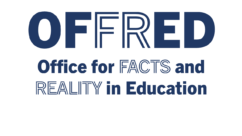A school will be rated Dangerous if :
“There is evidence that the policies at this school pose a high risk of psychological or physical harm to its students.”
What does this mean?
Evidence
First, OFFRED must be in possession of materials or testimony or other proof that the school has policies that are demonstrably dangerous.
Policies
School policies can be explicit (the school publishes what it is doing), so published policy documents can constitute evidence; or policies can be implicit (what constitutes the ‘ethos’ of the school), so letters received, or actions witnessed can be used as evidence.
Dangerous
Dangerous policies are those that pose a high risk of psychological or physical harm. For example: A policy that would ‘affirm’ a ‘transgender identity’ wanted by a student would pose a risk to both psychological and physical wellbeing.
This risk is documented in The Gender Affirmative Treatment Model for Youth with Gender Dysphoria: A Medical Advance or Dangerous Medicine?
So-called ‘social affirmation’ is a psychological intervention which a school is not qualified to exercise. It can foreclose a students exploration of who they are and how they fit into the world. Moreover, once a child feels that their fantastical new identity is endorsed by a school they might then seek harmful medical interventions to comply with the stereotypical norms associated with their new, false identity.
The Government recognises the risks in teaching about what it terms ‘gender identity’ in schools. Don’t label pupils’ gender identity, teachers told
The Attorney General says this about social affirmation:
Schools should consider each request for social transition on its specific circumstances, and individually, and any decision to accept and reinforce a child’s declared transgender status should only be taken after all safeguarding processes have been followed, medical advice obtained, and a full risk assessment conducted, including taking into account the impact on other children.
Suella Braverman MP, Attorney General
